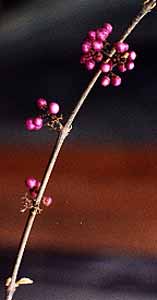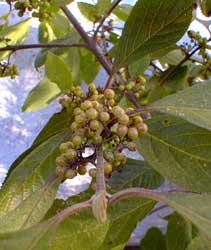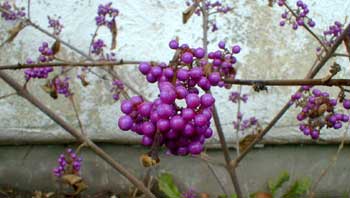
'Profusion' Beautyberry;
or, Bodinier's Beautyberry
"And there, back from the road, the specimen
Shrubs & small trees my father planted, some
Taller than we were, some in bloom, some berried,
And some we still brought water to."
-Edgar Bowers
(1924-2000)
(1924-2000)
'Profusion' Beautyberry is slightly more compact than the loosely limbed species (Callicarpa bodinieri var giraldi), & perhaps a foot shorter, reaching on average six or eight feet tall rather than eight to ten.
 It has a largely upright twiggy appearance that can become a vase-shaped shrub in time. Small lilac or purply-pink flowers occur July & August. These blooms are small & sometimes described as unimportant, but really they're quite pleasing, merely very close to the branches & therefore easily lost amidst the large green leaves. They form clusters of green berries by September, as shown in the second photo below snapped in 2003.
It has a largely upright twiggy appearance that can become a vase-shaped shrub in time. Small lilac or purply-pink flowers occur July & August. These blooms are small & sometimes described as unimportant, but really they're quite pleasing, merely very close to the branches & therefore easily lost amidst the large green leaves. They form clusters of green berries by September, as shown in the second photo below snapped in 2003.It is the tiny fruit that ripen in October that make this a stand-out among ornamental shrubs. When the deciduous leaves have fallen, the beautyberry fruits cling to the branches in gorgeous clusters. The limb portrait up first & third photos which were taken in December (2002 & 2003 respectively). Several more fruit portraits show their development stage by stage, on the Callicarpa bodinieri Page of the Winter Berries Gallery.
These shimmering fruits are drupes rather than true berries; they are not regarded as edible, though they are not toxic. They taste bad enough even deer dislike them, & they aren't particularly fond of the pungeant leaves either. The bad taste means the gorgeous berries are apt to last quite long into winter, though when there are no more food options in the landscape, birds or deer may finally get 'round to them.
 The leaves sometimes gain a pinkish glow in autumn while the berries are ripening to a neon-metallic violet, but often the autumn leaf color is no big deal, going quickly from green to muddy yellow to grey. The berries & autumn leaves are only briefly displayed together, then the leaves drop, leaving the berries to shine on their own. It is after leaf-fall that the berries are so very startling, shimmering so intensely that one almost expects they could glow in the dark, contrasting greatly with the plain grey twigs & tiny leafbuds. As no other berry is anywhere close to this color, it is one of the true winners for keeping the garden beautiful in winter.
The leaves sometimes gain a pinkish glow in autumn while the berries are ripening to a neon-metallic violet, but often the autumn leaf color is no big deal, going quickly from green to muddy yellow to grey. The berries & autumn leaves are only briefly displayed together, then the leaves drop, leaving the berries to shine on their own. It is after leaf-fall that the berries are so very startling, shimmering so intensely that one almost expects they could glow in the dark, contrasting greatly with the plain grey twigs & tiny leafbuds. As no other berry is anywhere close to this color, it is one of the true winners for keeping the garden beautiful in winter.An adaptable shrub, it tolerates wet or dry, sun or part shade, rich or depleted soil, but here in the Northwest, to maximize berry production, it is best placed in full sun with humousy acidic well-drained soil. It is best for zones 6 through 8; it does poorly in warmer climates. Even so, it fruits best if it experiences temperate winter & spring followed by a longish & fairly warm summer, which is why it is best placed in full sun. It will thrive in semi-shade but without the same number of berries. Berries can be further maximized for autumn & winter by lightly fertilizing the shrub monthly during the leafy months of spring & summer.
Bodinier Beautyberry is native of western & central China. The species is named after Emile Marie Bodinier (1842-1901), a French missionary in China who was first to collect this shrub for introduction to Europe. C. bodinier as well as C. japonica are used as medicinal herbs especially in the Chinese pharmacopeia, while the North American species C. americana was long ago used by Native Americans for sundry medicinal purposes.